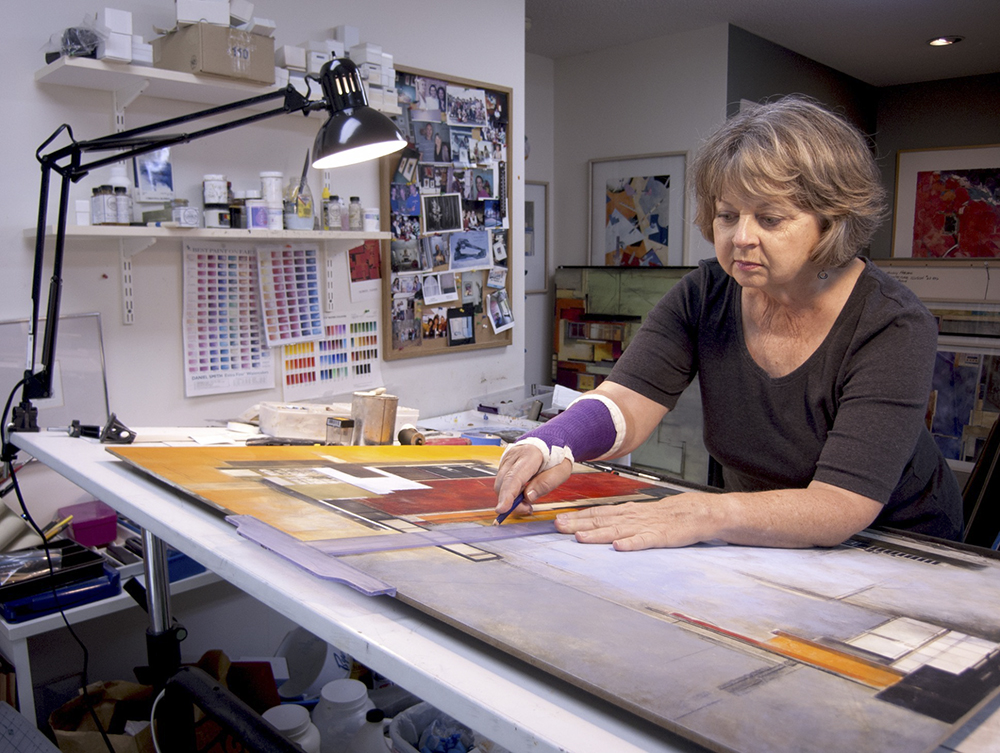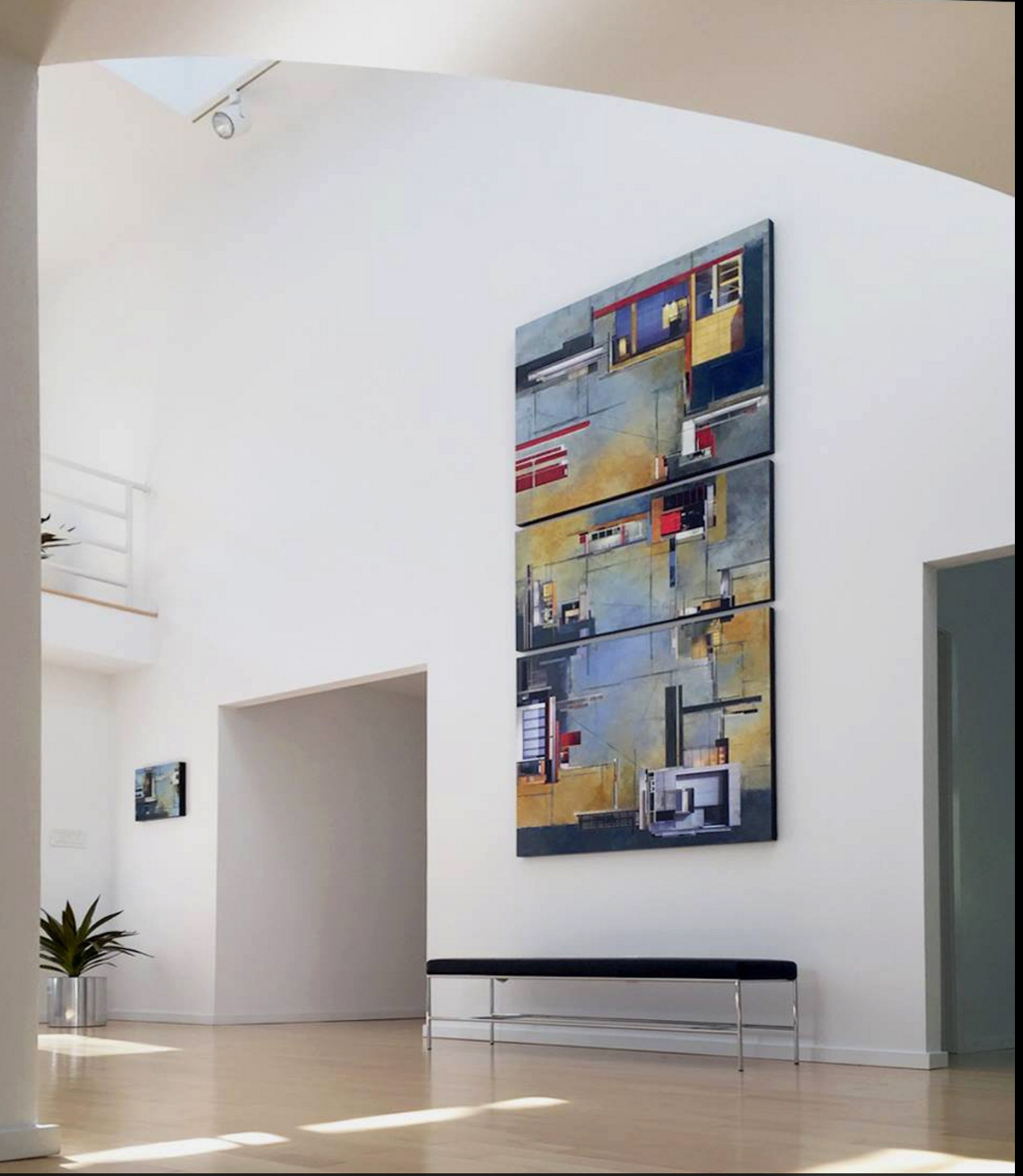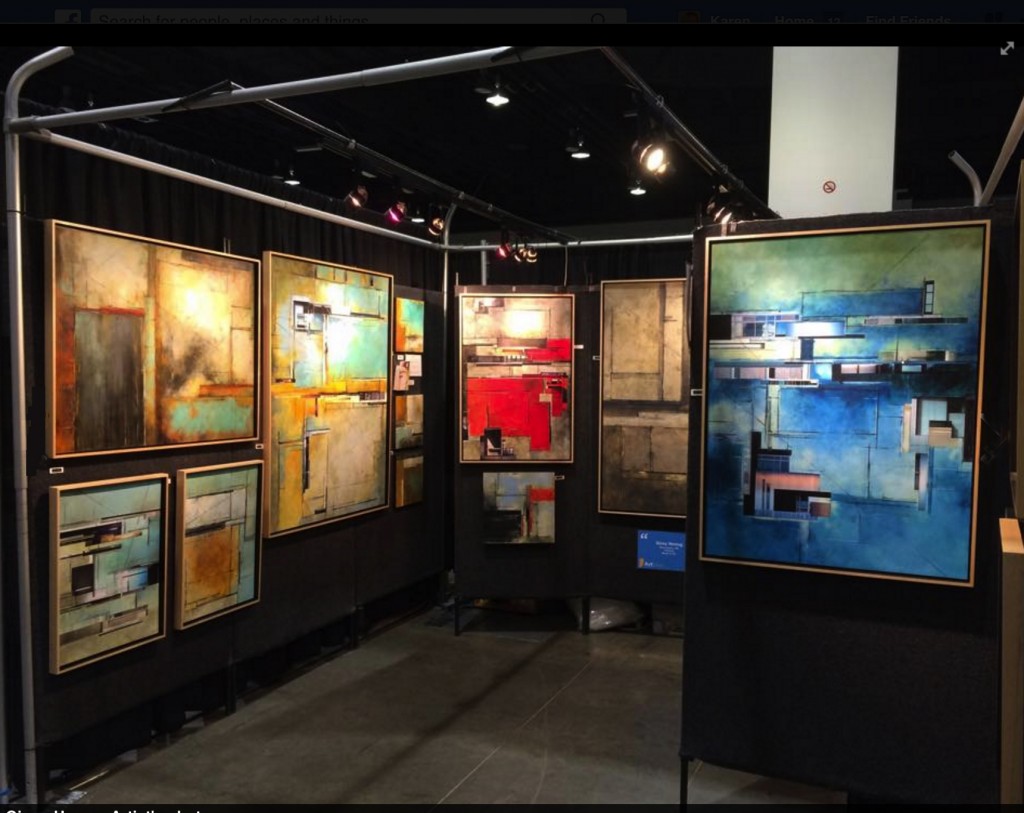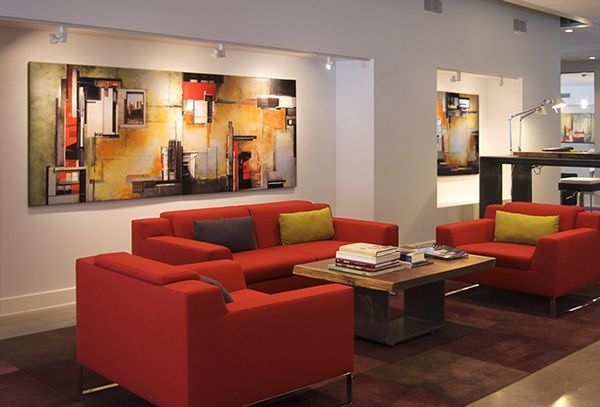Studio Business – Ginny Herzog
Studio business is a feature of Metropolitan's blog that offers interviews with working artists. It is meant to show a diversity of views and share information about how to make a living as an artist and have a successful career in studio arts. This interview was conducted with Ginny Herzog.

ARTIST STATEMENT
Architecture has been the inspiration for my art for over thirty years. An early career as an interior designer instilled in me a fascination with the design of floor plans and elevation drawings. I manipulate my digital photos of architecture in Photoshop, frequently eliminating objects or distorting the context of the original image. Piecing portions of different architectural elements that are unrelated to each other, I construct new, intriguing, familiar, yet unfamiliar architectural forms in my paintings. My application of oils, mixed with cold wax medium sometimes suggest fresco walls, concrete or steel; linear detail with graphite and pencils provides a visual pathway throughout the painting and may imply elements of an architectural drawing. All works displayed are original on archival Claybord panels.

Can you tell us about how you got started in your career?
I have a B.A. in Studio Art from St Cloud State University. After graduating, I did not know of anyone that was making a living doing their art. I had three different jobs in the first four years that eventually pointed the way to becoming a full-time artist and choosing my subject matter.
My first job was working in drapery fabrics in a department store, thinking that it might open some doors to doing interior design. My second job was assisting an interior designer at an office furniture company, where I learned to do presentation boards. The experience from the first two jobs and my portfolio secured a position as the in-house interior designer for a major homebuilder, where I did the interiors of all of the model homes. When we started our family I decided to remain at home to raise our kids so I returned to my art roots and began painting. I marketed my work at local art fairs. After a divorce, I decided to do my art full-time and began exhibiting at art fairs all around the country and at occasional art galleries.
Did you have any important mentors along the way?
When I started to do the shows full-time, I had one mentor, another artist who was doing art fairs all around the country and was very successful. I teamed up with her and we did most of our shows together for safety as well as economics. She did drawings and I did watercolors. Many of us who have done the shows for decades, network with each other. There are many resources for artists available now, particularly through the internet and social media.
What are the advantages of marketing through art fairs?
You have control of your own destiny. The artist can decide which shows they want to apply. There are no commissions to share. The artist keeps all proceeds from sales of the art. Artists seldom pay commissions to shows (only a handful of shows take a commission). The artist can exhibit a large amount of work. You can exhibit more artwork than a typical gallery exhibit. (I usually display 40-50 paintings at a time).

ARTDenver METROPOLITAN floater frame: Profile: 122 Wood: Maple Finish: 01 clear lacquer w/ black interior
You can get immediate payment. Mobile transactions are easy and safe with PayPal and Square. No need to accept risky check payment. Shows provide a large attendance. Shows do heavy promotions and advertising which brings in large attendances (tens of thousands to hundreds of thousands of people) - far more than gallery exposure. There are thousands of art fairs around the country. Some are indoors but most are outdoors. Art fairs are unique in that the artist can create work and take it to market at a show and expose it to thousands of people on a weekend. You can get instant feed back on your work. If successful, it is fuel for your creative engines to go home and create more! Rarely happens with the gallery scene that ties up work for months or years and the artist never hears the feed back of the collectors, except for a gallery opening. It provides an opportunity for the artist to discuss their work with collectors allowing them to establish a relationship.
The Shows provide the site and many amenities (reduced hotel fees, free parking for artists, programs, website presence with artist gallery, artist hospitality, volunteers for booth sitting, sometime electricity. Many of the shows also offer perks such as prize money and often winners are invited back jury free the following year.
There are hundreds of shows across the country and they are easy to apply online via Zapp or Juried Art Services.
Owning the mailing list is a huge asset for an artist. (If marketing through galleries they own the database. If you are no longer represented by the gallery for any reason you do not have access to the database.) Most of my marketing is done to my email list of interested clients that are organized according to geographical location. Announcements are sent out for my exhibitions via Constant Contact approximately eight times per year. The announcements include the names of the shows, dates, location, my booth number, images of some of the work available at the exhibition and links to the show’s website as well as my website.
What are the disadvantages of marketing through art fairs?
There is an initial investment in a vehicle for transporting the
work and display. In addition to the vehicle you will need a display system and canopy, lighting, weights, a dolly, a chair and insurance. The blind jury system can be hit or miss. Top shows are very competitive with only about 12-20% of applicants being accepted. Weather - heat, cold, humidity, rain, wind, and yes, even snow can be a factor. Even if the weather cooperates artists are sometimes at risk for having a poor booth location at a show.
Because of the increase in the number of art fairs, the market has become over saturated. Some of the large, older shows had a fabulous reputation for great sales 10-30 years ago, when artists often made in excess of $10,000 in sales at a show. Some of the artists were doing $20k - 30k! We have lost many of our middle class buyers. Now, many of the buyers are buying expensive pieces and the rest of the crowd comes for free entertainment and only to enjoy looking at the art.
I know that you have sold your work internationally. Can you tell us more about how that happened.
An architect/collector of mine was working on the creative team for a project by Brunsfield the developer of the Brunsfield North Loop apartments in Minneapolis. Brunsfield International is a global development, management, engineering construction and real estate investment company. A meeting was set up in my studio so they could see the process of how my work is created and to discuss how I might create work specific for their project in the lobby. Initially, six large paintings were created, but as the project was nearing completion, more of my work was added to the other public spaces as well as the models. Because they needed a large number of pieces and I was also in the middle of my busy exhibition schedule, I was creative in putting together additional inventory for them to use in the form of reproductions, or leased originals from my collection. Currently, about 34 of my paintings are hanging at BNL. At the time of installation of the final pieces in the lobby, the Managing Director of Brunsfield International in Malaysia was here in Minneapolis with members of his corporate team. They visited my studio to see my work and purchased the six original paintings for their corporate office as well as several others for their projects.

Can you talk about how you present your work?
Several years ago, I was looking for a new frame supplier and Metroframe was highly recommended. I went to them with one of my flat panels and asked for a profile , a neutral float frame that was minimalistic, architectural and would provide protection for my flat panels. Metroframe designed a clear maple float frame with a black interior that has been my mainstay for framing all of my flat panels.
I have 1" spacing around the interior. All of my framed pieces are presented in this profile at my shows. In addition, their frames stand up to the rigors of being transported throughout the country to various exhibitions.
In the past, customers would ask if they could substitute a different finish. Not any more. They love these frames from Metroframe and often comment about the quality.
I believe consistency in presentation helps the customer to make a final decision about their purchase.
What advice do you have for artists who want to try marketing their work in outdoor art fairs?
You need at least 5-6 high quality digital images of individual pieces of your work and one booth image to apply to the art fairs. The work should look consistent but show the range of sizes or items that you will be selling. The digital images will need to be in the file format and size specified by Zapp or Juried Art Services.
Some art fairs have a portion of their show for Emerging Artists. They often provide the canopies for these artists and the booth fees are often at a reduced rate. This is a good way of "testing the waters" to see if you might have a market for your work at the art fairs.
Classes that would be very helpful for marketing your own work: Basic accounting, graphic design (for doing announcements and ads), website design, basic Photoshop.
Art Fair artists often do a lot of networking - sharing valuable information about many of the shows or tips for the road. We have several FB groups, however many are closed groups - someone needs to vouch for the artist that they are art fair exhibitors. These groups are closed to show directors or the general public. There are also artist Garage Sale pages for selling art or display materials.
Some art fairs have the beginning round of jurying open to the artists so that they can see the work projected as the jury sees them. This is very valuable for seeing how your work compares to your competition.
Some of the art fairs offer hosting for the artists (free place to stay in private homes).
What kind of accounting software do you use?
I use QuickBooks for Accounting. Fox Tax (for artists) for my tax returns.
I use an accordion folder file to file my receipts for business expenses. Receipts are not filed until they are entered into my Quickbooks software. I use mileage for my auto expenses. I fill out a tax expense worksheet, provided by my tax accountant, Fox Tax. Fox Tax in Minneapolis only does taxes for artists so they really know our business and I highly recommend them.
How do you price your work?
I price my work by size. Framed work is higher than the cradled panels because of the extra cost. I've never lowered my prices, however, beginning in 2008, I quit raising my prices and have held them stable. Prior to that, I raised my prices 10% per year. I have a collectors discount of 10% for repeat customers or customers who buy multiple pieces at a time. Interesting fact - my customers rarely ask for a discount.
Do you have a website? Do you manage it yourself? Do you get sales from your website?
I've had a website for 20 years. The platform I use is Other Peoples Pixels (website template for artists). I manage it myself and it is always current with available work including sizes and prices. Yes, I often get sales from my website. The prospective customer emails me with their inquiry and I email them an invoice via Square which they can pay online.
What kind of hardware do you need to maintain your website?
I use a MacBook Pro, iPad Mini and iPhone as well as a Nikon CoolPix 8400 camera.
Most of my sales are done out in the field so I use Square software on my iPhone or iPad. A receipt for the credit card transaction is emailed to them. However, I write out a separate, additional receipt for my business to track the clients contact info and for inventory purposes.
How do you use social media?
I have a business Facebook page. Also use Pinterest and share my Pinterest page with other artists. I automate some of my e-announcements (Constant Contact with my FB pages - both personal and business.
I see that you were just featured in Forbes magazine. Can you tell us how that occurred?
As for the Forbes article, the free-lance writer approached me at my booth at Uptown. I have no idea of his criteria for selecting the artists that he has included in his articles. I think it was merely that he liked my work. I think I was in the right place at the right time.
I've also been featured in Midwest home a couple of times and in blog articles. The writers have approached me and asked to interview me for their publication.
